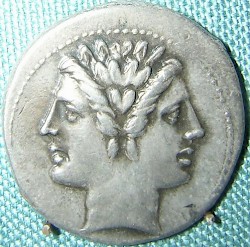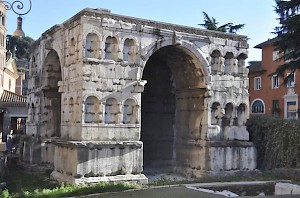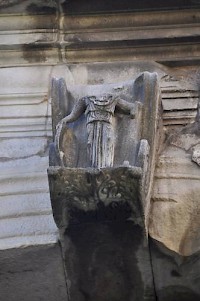Rome, Arch of Janus Quadrifrons
Q580555Arch of Janus Quadrifrons: monument in Rome from the fourth century.

The two-headed god Janus, who was originally venerated in the valley of the Lower Tiber, belongs to the most ancient and most venerable members of the Roman pantheon. He was considered to be the "god of the gods" and was believed to guard all kinds of doors and gates. This god was also invoked at the beginning of every sacrifice, which is why modern scholars tend to believe that Janus had something to do with beginnings in general. From the reign of the emperor Domitian (r.81-96) on, Janus was sometimes represented with four heads, called Janus Quadrifrons.
The massive (and not particularly attractive) Arch of Janus Quadrifrons at the Velabrum marks the northeastern limit of the Forum Boarium, the cattle market of ancient Rome. The core of the monument was constructed from bricks, and the surface was covered with white marble. The building was probably erected by the emperor Constantine I the Great (r.306-337) and was therefore also called Arcus Constantini.

The exact significance of this monumental arch, which was built on top of the Cloaca Maxima, is poorly understood, although we can be quite confident that this arch, dedicated to a pagan god, is at odds with the often-repeated claim that Constantine converted to Christianity in 312. This arch suggests a later conversion.

It is likely that the arch was once better decorated; there must have been statues in the forty-eight, now empty niches. Nothing is left. Some of the ancient ornaments, however, survive. The third photos shows a small detail of one of the arches: at first sight, it may be the goddess Minerva. However, the type of representation makes it likely that this in fact is the sacred statuette called Palladium, a statue of the goddess that had once fallen from the skies and had - according to the Roman poet Virgil - been taken from Troy to Italy by the hero Aeneas.